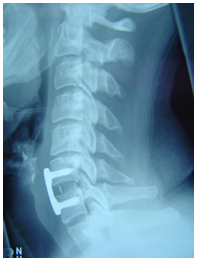In Hospital
 Upon return to the ward following surgery a soft spongy collar will be in place and a tube will be draining the neck wound. Ward nursing staff will frequently make routine checks and observe the function of the arms and legs. Patients should immediately report particular difficulty in swallowing or breathing at any time following the surgery. Pain relieving medications will be available for use as required. TED (Thrombo-Embolic Deterrent) stockings will be in place and should be worn for 6 weeks after the operation in order to avoid blood clotting in the legs.
Upon return to the ward following surgery a soft spongy collar will be in place and a tube will be draining the neck wound. Ward nursing staff will frequently make routine checks and observe the function of the arms and legs. Patients should immediately report particular difficulty in swallowing or breathing at any time following the surgery. Pain relieving medications will be available for use as required. TED (Thrombo-Embolic Deterrent) stockings will be in place and should be worn for 6 weeks after the operation in order to avoid blood clotting in the legs.
Swallowing may be uncomfortable for the first 12 to 24 hours, however fluids and a diet may be taken as desired. The hip wound (where bone graft has been harvested) may be particularly uncomfortable and our physiotherapist will assist in mobilisation usually on the day of surgery.
On the day following surgery the wound drain will be removed and an x-ray of the neck will be performed. Ward mobility will be encouraged with the help of our physiotherapist.
On the third day after surgery the skin staples in the neck wound will be removed and the patient will be allowed home. The soft spongy collar will be worn for 6 weeks. It is safe to travel home as a front seat passenger wearing a seat belt. Driving should be avoided for 6 weeks after the surgery.
A clear rubbery wound dressing is applied to the hip wound which should remain in place for 2 weeks. This dressing is water resistant and showers may be taken, however the wound should not be immersed (bath, swimming pool) for the first fortnight.
At Home
At 2 weeks following the day of surgery a visit to the local general practitioner should be made for removal of the hip wound dressing so that satisfactory healing may be confirmed. The sutures are under the skin and do not need removal.
Activity should recommence gradually
- In the first 2 weeks - activity should be confined largely to the home and involve only personal hygiene and minor tasks involving no exertion.
- From 2 weeks (the time of wound dressing removal) to 4 weeks - a gentle exercise program may be instituted. This will include activities such as gentle walks around the neighbourhood, swimming or use of an exercise bike. The exercise program provided by our physiotherapist will also be in place.
- At 4 weeks after the operation, general household duties (without bending or lifting!) may be recommenced and the exercise program stepped up.
In a non-manual occupation, work could recommence at 4 weeks. Please note that, as driving is not permitted for six weeks following the surgery, alternative transportation to the workplace will need to be arranged. In a manual occupation 6 weeks away from work will be required. Wherever possible, recommencement at work for both manual and non-manual workers is most desirable in half days for the first week, after which full active duty may be undertaken.
The first postoperative visit with Assoc. Professor Richard Williams is usually at the 6 week mark (or just prior to recommencement at work). Patients will require an x-ray at this visit and should arrive for the appointment 30 minutes prior to the allocated time to allow for this.
At any time in the postoperative course Assoc. Professor Richard Williams is available to help or give advice regarding any difficulty which is being experienced.
